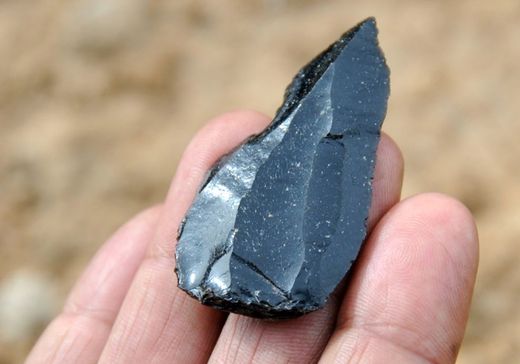
The oldest known stone-tipped projectiles have been discovered in Ethiopia. The javelins are roughly 280,000 years old and predate the earliest known fossils of our species, Homo sapiens, by about 80,000 years.
These javelins are some 200,000 years older than previous examples of similar weapons, suggesting that modern humans and their extinct relatives had the know-how to create these sorts of complex thrown projectiles much earlier than often thought.
Scientists investigated stone tools unearthed at the Gademotta Formation on the flanks of an ancient, large collapsed volcanic crater in central Ethiopia's Rift Valley.
"Today, the area represents a ridge overlooking one of the four lakes in the vicinity, Lake Ziway," said researcher Yonatan Sahle, an archaeologist at the University of California, Berkeley.
During much of the Middle Pleistocene, about 125,000 to 780,000 years ago, "the area was overlooking an even bigger paleolake - a megalake composed of today's four separate lakes." Antelope and hippo remains have been recovered from the grassy, forested site.
The oldest artifacts at the site are roughly 279,000 years old. In comparison, the earliest known fossils of Homo sapiens, previously discovered at sites elsewhere in Ethiopia, are about 200,000 years old.
Pointed artifacts with damage suggesting they were used in spears are common at the site. The researchers focused on 141 such obsidian artifacts.
The Tip of the Spear
"We were only interested in testing the hypothesis that these tools were definitely used to tip spears," Sahle said. "The eureka came much later as we did the analysis and found out that the features we were dealing with were the result of throwing impact, not thrusting."
When pointed artifacts are used as weapons, V-shaped fractures, called fracture wings, can form at the moment of impact; the apexes mark where the cracks started. Past experiments in materials such as obsidian have shown that the narrower the V-shapes of fracture wings, the higher the speed of the fracturing that created them.
The researchers discovered that the fracture wings seen in a dozen of these obsidian points suggest that the fracture cracking sped faster than 1,820 miles an hour (2,930 kilometers an hour). In experiments with thrusting spears, that's the maximum velocity seen in fracturing. And some of these artifacts apparently developed fractures after impact at speeds of up to 3,345 miles an hour (5,385 kilometers an hour), close to the maximum velocity seen with fracturing in thrown spears.
A number of these artifacts are among the oldest at the site, suggesting that javelins were used as early as 279,000 years ago. Such weapons are considered signs of complex behavior and were pivotal to the spread of modern humans.
"The implication is that certain behavioral traits that are considered complex and mostly only the domains of anatomically modern humans - such as the capacity to make and use projectiles - were not only incorporated into the technological repertoire of the African early Homo sapiens, but also had earlier roots and were present in populations ancestral to Homo sapiens," Sahle said.
Advantages of Throwing
The invention of projectile weapons was a major advance over thrusting spears carried in hand. Projectiles empowered prehistoric hunters to strike at a distance, reducing the risk of injury from dangerous animals and broadening the range of prey that people might capture.
Paleoanthropologist John Shea at Stony Brook University, in New York, who did not take part in this research, said these findings were sound.
"In this area, I can see these thrown spears probably being used against crocodiles, hippos, or some other big animal that one could get close to with boats," Shea said.
Stone-tipped hunting spears appear in the fossil record beginning about 500,000 years ago. However, these were thrusting spears, not thrown javelins. Until now, the oldest conclusive evidence dated such projectiles at 80,000 years old.
The creator of the most ancient obsidian javelins found at Gademotta was probably Homo heidelbergensis, the most likely ancestor to modern humans and Neanderthals, Sahle said. There may be no way to determine whether Homo sapiens discovered how to make these weapons independently or if they learned how to do so from Homo heidelbergensis.
Shea noted many complex behaviors started appearing between 200,000 and 300,000 years ago. "You see a shift in anatomical structures that would have allowed us to speak, and a shift toward more complex tools," he said. "I think the advances seen here in tools have to do with the emergence of language."
Shea cautioned not to read too much into the fact that these findings were made in Ethiopia. "It's often assumed that the earliest discovery of anything is the first instance of anything," Shea said. "This is just the oldest example we have so far of this technology - it doesn't mean that this is where it first evolved."
He suggested similar research could be conducted at other sites "to see how widespread similar points are, to see if everyone at this time is doing the same thing or if there are regional differences."
In the future, the researchers would like to discover when humans began using even more complex mechanically propelled weapons, such as the bow and arrow, and the spear-thrower known as the atlatl, which may have been developed between 60,000 and 100,000 years ago. These weapons may have helped modern humans expand out of Africa and outcompete Neanderthals, they noted.
The scientists detailed their findings online November 13 in the journal PLOS ONE.



I may be misreading this in some way but the text seems to suggest that these spears were thrown at 0.5 to 0.9 miles per second! Wow!
More than twice the speed of a handgun bullet. As the spear (javelin) cannot travel faster than the human hand that throws it the poor throwers hand would disintegrate!